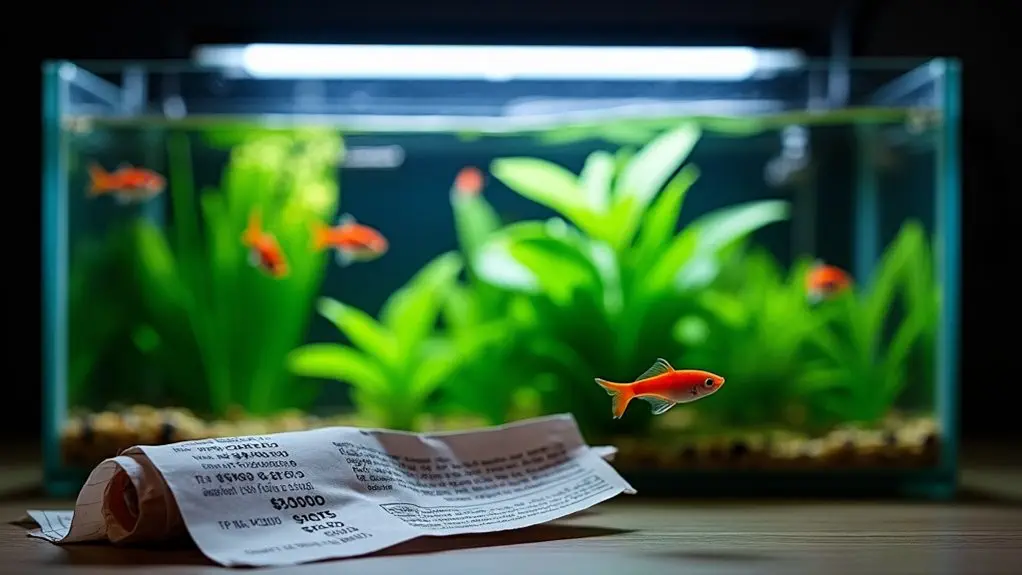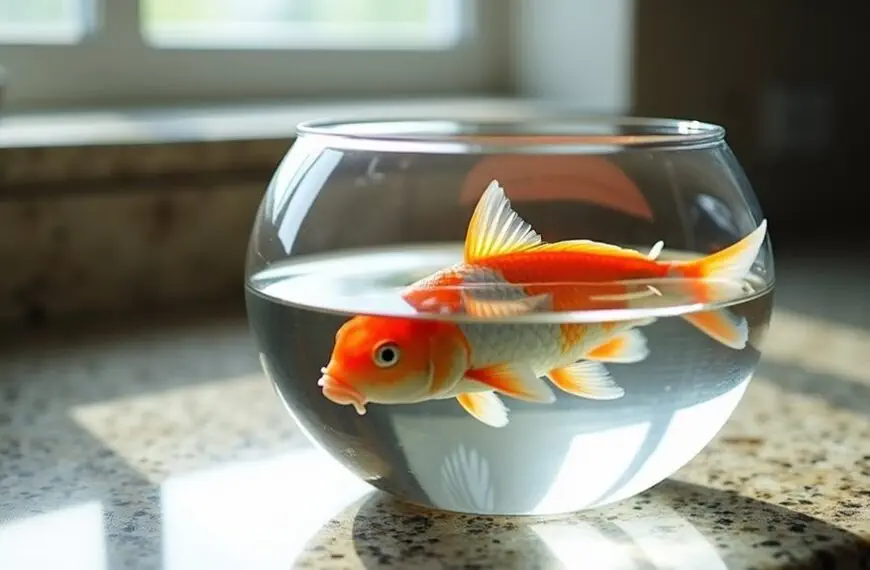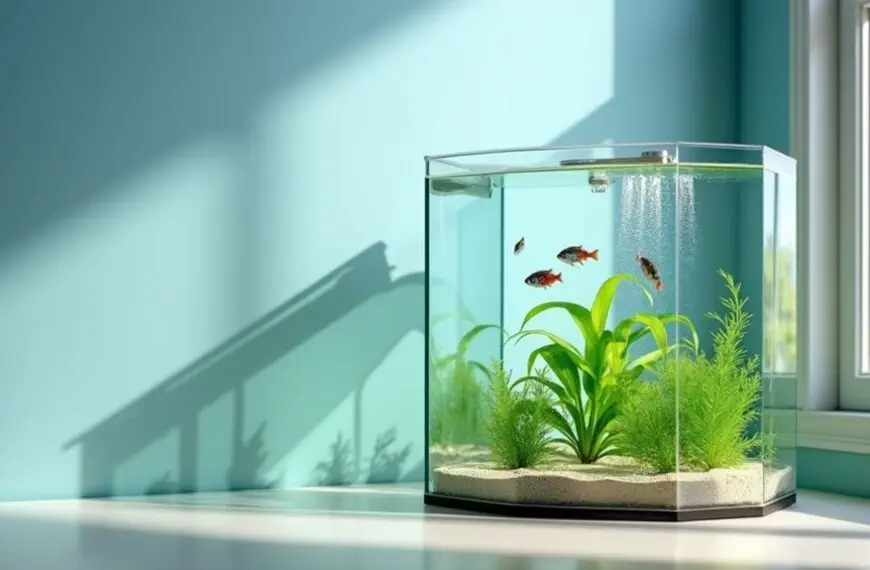Fish aren't as cheap to keep as you might think! While a single fish may only cost a few dollars, you'll need to factor in the initial setup costs ($100-$500+) for equipment like tanks, filters, and heaters. Monthly expenses add up too, with food costing $5-$20, increased utility bills ($5-$20), and regular water testing supplies. Don't forget about potential vet visits ($50-$300) and emergency treatments ($10-$50) that might pop up. With proper planning and maintenance, though, you can create a budget-friendly aquarium experience that won't leave your wallet swimming upstream. There's much more to discover about managing these costs effectively.
Contents
- 1 Hidden Costs of Fish Ownership
- 2 Essential Equipment and Supplies
- 3 Monthly Maintenance Expenses
- 4 Tank Size and Setup
- 5 Water Quality Testing Requirements
- 6 Healthcare and Veterinary Needs
- 7 Food and Nutrition Costs
- 8 Long Term Financial Planning
- 9 Frequently Asked Questions
- 9.1 How Do Fish Insurance Policies Work and What Do They Cover?
- 9.2 Can Fish Tanks Increase Home Energy Efficiency by Regulating Room Temperature?
- 9.3 Do Different Species of Fish Affect Property Value Differently?
- 9.4 What Tax Deductions Are Available for Educational Fish Keeping Programs?
- 9.5 How Do Seasonal Changes Impact the Cost of Maintaining Tropical Fish?
- 10 Final Thoughts
Hidden Costs of Fish Ownership
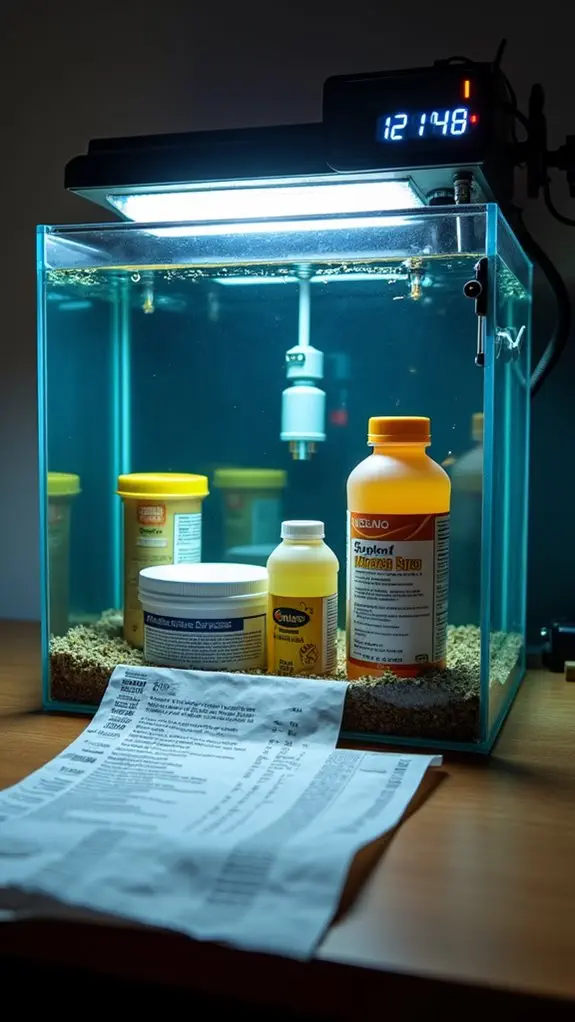
Many people assume fish are inexpensive pets, but the hidden costs of fish ownership can quickly add up. While you might think you're just paying for a small fish and a tank, there's actually a whole world of expenses waiting beneath the surface. Your initial setup costs can range from $100 to $500 or more, depending on the size of your aquatic kingdom and the equipment you'll need. Just like with boats, thorough research beforehand can save you from unexpected financial strain down the road. Maintaining good water quality is essential for fish health, which often requires additional testing kits and conditioners.
You'll also need to factor in those sneaky monthly expenses that aren't always obvious at first glance. Your utility bill might creep up by $5 to $20 just from running the tank equipment, and you'll need to budget for regular food and maintenance supplies. Annual maintenance for larger aquariums can exceed one thousand dollars.
Don't forget about those unexpected expenses that can pop up too – from equipment failures to fish health emergencies that could cost anywhere from $10 to $50 per treatment. If you're busy, you might need to hire professional maintenance services, which can set you back $50 to $200 per visit.
While fish can be wonderful pets, it's important to understand that their care involves more than just dropping food in the tank each day.
Essential Equipment and Supplies
Setting up a proper fish tank requires several essential pieces of equipment and supplies that work together to create a healthy aquatic environment.
You'll need to start with the basics: a sturdy tank, reliable stand, and secure lid to keep your finned friends from practicing their Olympic diving skills! For beginners, a freshwater tank setup is recommended due to easier maintenance and lower costs.
Don't forget the crucial filtration system – it's like a tiny water treatment plant for your aquatic pals. Testing equipment is essential since high mortality rates can occur when water parameters aren't properly maintained.
When it comes to tank maintenance tips, you'll want to invest in a quality siphon for water changes and an algae scraper to keep those glass walls crystal clear.
A thermometer and heater are must-haves to maintain the perfect temperature for your specific fish species.
Speaking of fish species compatibility, you'll need a trusty fishnet for safely moving your swimmers and a quarantine tank for newcomers or under-the-weather residents.
Remember to grab a dedicated water bucket (no soap residue allowed!), and consider investing in some reference materials to become a fish-keeping pro.
While the initial equipment list might seem long, these tools are crucial investments that'll help maintain a thriving underwater community for years to come.
Monthly Maintenance Expenses
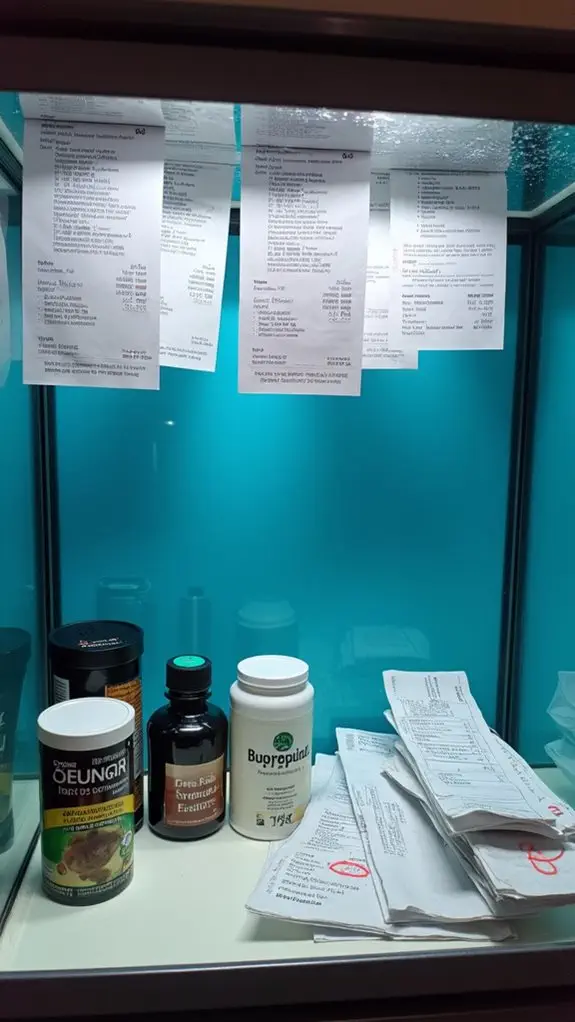
You'll need to budget around $5-$15 monthly for fish food, depending on your tank size and the types of fish you're keeping. Setting up the right aquarium size is crucial, with experts recommending one gallon per inch of fish you plan to keep. Regular water testing becomes part of your routine, with each test costing about $0.10 if you're doing it at home or up to $2 at stores, though some pet shops offer free testing for loyal customers. Regularly monitoring water quality parameters is essential to ensure a healthy environment for your fish. While these basic maintenance supplies might seem like small expenses, they're essential for your fish's health and will help you avoid costly problems down the road. Your monthly utility bills may increase by $5-$20 due to running filters, heaters, and lighting equipment.
Essential Monthly Supply Costs
Running a fish tank comes with several predictable monthly expenses that you'll need to factor into your budget. When it comes to essential supplies, you'll find that budgeting strategies can help you manage these costs effectively.
Basic water testing supplies will need frequent replenishment, with testing costs averaging $0.60 weekly.
Your monthly food expenses typically range from $5 to $15, depending on what kind of fish you're keeping and how many hungry mouths you're feeding.
For a cost comparison, think about it this way: you'll spend about $0.014 per gallon weekly on dry food for a basic freshwater setup, while specialty diets might push that up to $0.035 per gallon. If you've got goldfish, you're in luck – they're relatively inexpensive to feed at just a few dollars monthly. Many tank owners find that hiring professional services starting at $50 can help manage these ongoing costs more effectively.
Equipment operation will add another $5 to $20 to your electricity bill, depending on your tank's size and setup.
The good news is that you can control these costs by making smart choices. For instance, buying quality food in bulk often saves money in the long run, and investing in energy-efficient equipment can help reduce your monthly utility expenses.
Just remember, skimping on essential supplies isn't worth the risk to your finned friends' health.
Regular Water Testing Expenses
When it comes to regular water testing, maintaining your aquarium's health requires a consistent investment in reliable test kits.
You'll find various test kit types available, from basic freshwater kits starting at $35.98 to advanced multiparameter checkers that can run up to $449.99. While these initial costs might make your wallet wince, they're essential for your finned friends' survival. The comprehensive 8-in-1 test strips offer a cost-effective solution for monitoring multiple water parameters simultaneously.
Your testing frequency will depend on your aquarium's size and type. For most setups, you'll need to test weekly or monthly to keep tabs on vital parameters like pH, nitrates, and ammonia. Many aquarists rely on disposable transfer pipettes for precise measurements during testing.
If you're running a saltwater tank, you might want to invest in specialized kits like the Salifert Master Reef Testing Combo Kit ($99.99), while freshwater enthusiasts can often get by with the trusty API Freshwater Master Test Kit.
Don't forget about those handy test strips – they're perfect for quick checks between thorough testing sessions.
Tank Size and Setup
Selecting the right tank size is an essential first step that impacts both your fish's health and your maintenance routine.
When you're considering tank dimension impact and fish species compatibility, remember that bigger isn't always better unless you're planning to expand your aquatic family quickly.
While those tiny tanks might look cute in your living room, anything under 5 gallons is risky for your finned friends.
You'll want to start with at least a 5-gallon setup if you're thinking about a betta fish, or go bigger with a 20-gallon tank if fancy goldfish are swimming through your dreams.
Medium-sized tanks (21-40 gallons) offer more stability and flexibility, letting you keep 6-12 small fish comfortably.
Don't forget to factor in space for equipment – you'll need room for filters, heaters, and those inevitable maintenance sessions.
If you're eyeing active swimmers like zebra danios or tall, graceful angelfish, you'll want to pay special attention to tank dimensions.
After all, you wouldn't want your fish feeling like they're living in a cramped studio apartment when they deserve a spacious underwater penthouse! Additionally, consider how proper water quality management can greatly enhance your aquarium's stability and your fish's overall well-being.
Water Quality Testing Requirements
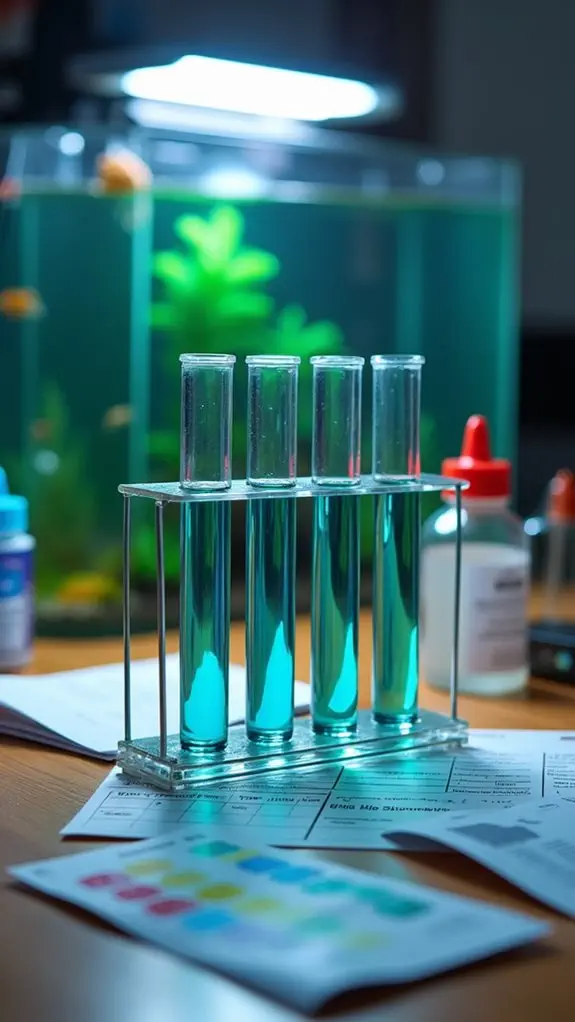
Once your tank is set up, maintaining healthy water conditions becomes your next priority. You'll need to invest in reliable testing equipment to monitor vital water parameters like pH, ammonia, and nitrites. Water parameter significance can't be overstated – even small changes can stress or harm your fish.
Testing frequency importance is something you shouldn't overlook. While it might seem tedious, monthly testing is the minimum requirement to keep your finned friends healthy. You've got options when it comes to testing methods: test strips are convenient but less accurate, while liquid tests give you more precise results. Think of it like a regular health check-up for your aquatic pets!
The good news is that basic testing kits aren't too expensive. You can start with an API master test kit, which covers essential parameters and lasts quite a while. It's also beneficial to remember that monitoring pH is crucial for preventing fish stress.
Don't forget that different fish species have specific water requirements, so you'll want to research what's best for your particular underwater community. While regular testing does add to your ongoing fish-keeping costs, it's far cheaper than dealing with sick fish or having to restart your tank due to water quality issues.
Healthcare and Veterinary Needs
The reality of fish healthcare isn't always as simple as many assume. When you're keeping fish, you'll need to be prepared for various medical expenses that can quickly add up. Just like other pets, your aquatic friends need proper veterinary services to maintain their health and well-being.
You'll want to budget for both routine and emergency care. Basic in-house consultations with a fish vet typically run between $50-$100, while those convenient at-home visits can set you back $200-$300.
Don't forget about those unexpected health issues that might pop up – they usually cost anywhere from $10-$50 to treat. In more serious cases, you might need emergency veterinary care, which can range from $50-$100 per visit.
The good news is that you can help prevent many fish health problems by investing in preventive care. Regular water testing kits ($15-$40) and quality water conditioners ($5-$20) are essential tools in your fish-keeping arsenal. Regular testing not only aids in fish health but also promotes a stable aquarium ecosystem.
Think of it as health insurance for your finned friends! Professional tank maintenance, while pricier at $50-$200 per session, can help catch potential issues before they become serious problems.
Food and Nutrition Costs

You'll need to provide quality food for your fish, which can cost anywhere from $5 to $20 monthly depending on the type and amount your finned friends require.
Some fish come with special dietary needs that might include a mix of pellets, frozen foods, and even live prey, making their menu more complex than you'd expect.
While it's tempting to grab the cheapest fish food on the shelf, investing in proper nutrition will help keep your fish healthy and vibrant, potentially saving you money on healthcare costs in the long run. Additionally, choosing high-quality fish food can enhance the overall health and color of your fish.
Quality Food Requirements
Providing quality food for fish requires careful attention to their complex nutritional needs. Your finned friends need about 40 essential nutrients, including proteins, carbohydrates, and lipids, to stay healthy and thrive.
While traditional fish foods like fishmeal offer excellent nutrient balance, they're often quite expensive, which is why many companies are developing feed alternatives using ingredients like soy, wheat, and even insect proteins.
You'll need to take into account your fish's specific dietary requirements, as they'll vary depending on the species and life stage. For example, baby fish (fry) need more protein than adults, and some species, like herbivores, process carbohydrates differently than carnivores.
It's a bit like having dinner guests with different dietary preferences – you've got to cater to everyone's needs!
To guarantee your fish get all their essential nutrients, you'll want to offer a varied diet that includes different food types. Think of it as a buffet: pellets, flakes, frozen foods, and even live treats.
Just remember not to overdo it – overfeeding can lead to water quality issues and unhealthy fish. Ensuring that your fish are fed a balanced diet not only promotes growth but also contributes to maintaining optimal water quality, which is crucial for their overall health.
Special Diet Considerations
Managing your fish's dietary costs requires a strategic approach based on their specific nutritional needs. You'll need to take into account your fish's dietary preferences and create a feeding plan that balances both nutrition and budget.
For instance, if you're keeping carnivorous fish, you'll want to focus on protein-rich foods that might cost more, but you can offset these expenses by buying in bulk or using frozen options.
When it comes to nutritional balance, remember that different fish have vastly different requirements. Your herbivorous fish will need plenty of plant-based foods with 15-30% protein content, while those meat-loving carnivores require a hefty 50-70% protein in their diet.
Don't worry though – you can get creative with your feeding strategy! Try mixing commercial foods with whole food options like krill or clams, which can actually save you money when bought in bulk. Also, regular monitoring of pH levels helps ensure that your fish are in the best environment to absorb nutrients effectively.
You might even find that using an automatic feeder helps you portion out meals more effectively, preventing that all-too-common "just one more pinch" syndrome that leads to overfeeding and wasted food.
Plus, your fish won't give you those guilt-inducing "hungry" eyes quite as often!
Long Term Financial Planning
Long-term financial planning for your fish tank requires three key components: consistent investment in quality equipment, strategic savings for upgrades, and a clear understanding of future maintenance costs.
Just like any other long-term financial goal setting, you'll want to break down your aquarium expenses into manageable chunks and plan accordingly.
Start by setting aside at least 20% of your monthly aquarium budget for future equipment replacements and upgrades. You'll thank yourself later when it's time to replace that aging filter or upgrade to a larger tank!
Investment diversification in your fish-keeping journey means not putting all your funds into just one aspect – balance your spending between equipment maintenance, water treatments, and food quality.
Consider opening a separate "fish fund" savings account where you can automatically transfer a fixed amount each month. This way, you won't feel the pinch when unexpected expenses pop up, like replacing a broken heater or treating a sick fish. Additionally, always keep in mind the significance of regular water changes, as they play a crucial role in maintaining water quality and supporting fish health.
Frequently Asked Questions
How Do Fish Insurance Policies Work and What Do They Cover?
You'll find fish insurance provides coverage through All Risks or Named Perils policies, protecting your stock, equipment, and vessels. It'll cover mortality, disease outbreaks, transit risks, and liabilities in your aquaculture operations.
Can Fish Tanks Increase Home Energy Efficiency by Regulating Room Temperature?
While your fish tank can provide some temperature regulation, it's unlikely to increase overall energy efficiency, as the power needed to run the tank typically exceeds any potential energy savings in room heating.
Do Different Species of Fish Affect Property Value Differently?
While fish species in lakes can impact property appraisal values, there's no clear data showing that indoor aquarium fish affect home values. You'll find outdoor water features matter more for property assessments.
What Tax Deductions Are Available for Educational Fish Keeping Programs?
You can claim tax deductions through educational grants and tax credits if your fish keeping program aligns with state guidelines. You'll need to provide 25% of costs and maintain proper documentation for business or educational purposes.
How Do Seasonal Changes Impact the Cost of Maintaining Tropical Fish?
You'll face higher costs during seasonal maintenance due to temperature fluctuations. You'll need to run heaters in winter and cooling systems in summer, while adjusting water parameters and equipment maintenance year-round.
Final Thoughts
While fish might seem like an inexpensive pet at first glance, you'll need to factor in all the hidden costs before diving in. From initial setup expenses to ongoing maintenance, keeping fish isn't as cheap as you'd think. However, with proper planning and budgeting, you can create a thriving aquatic environment without breaking the bank. Just remember, investing in quality equipment and care now will save you money and heartache in the long run.

